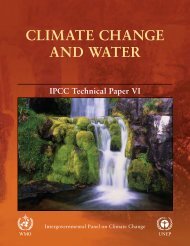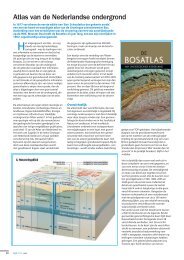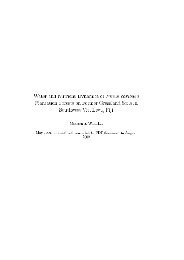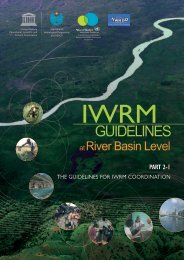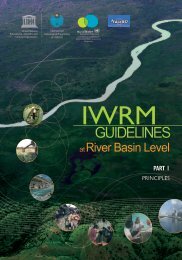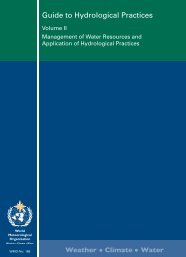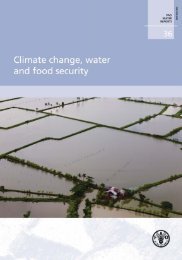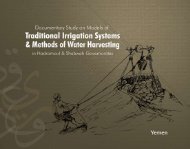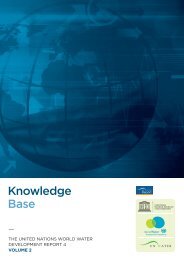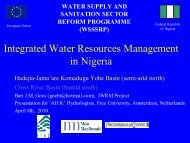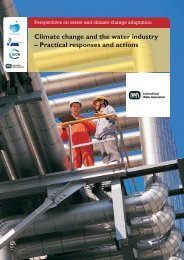Chapter 1Concept and importanceof non-<strong>renewable</strong> <strong>resources</strong>Jean Margat, Stephen Foster and Abdallah Droubi‘<strong>Non</strong>-<strong>renewable</strong> <strong>groundwater</strong>’ as a conceptGroundwater <strong>resources</strong> are never strictly non-<strong>renewable</strong>. But in certain cases the period neededfor replenishment (100s or 1000s of years) is very long in relation to the normal time-frame ofhuman activity in general and of water <strong>resources</strong> planning in particular. In such cases it makespractical good sense to talk in terms of ‘non-<strong>renewable</strong> <strong>groundwater</strong> <strong>resources</strong>’ (Table 1). Somehydrogeolgical settings which are often associated with non-<strong>renewable</strong> <strong>groundwater</strong> are illustratedin Figures 1 A-D.In nature aquifers have a capacity for both water storage and water flow, and thus <strong>groundwater</strong>simultaneously accumulates and circulates – the volume of <strong>groundwater</strong> stored in someof the larger aquifer systems is huge and represents some 97% of our planet’s freshwater<strong>resources</strong> (excluding that locked as ice in the polar regions).Groundwater resource renewal is a concept that derives from a comparison between thenatural flow and storage of aquifer systems (Table 2). The range in nature is extreme withrenewal periods of less than 10 years to more than 100,000 years. In cases where present-dayaquifer replenishment is very limited but aquifer storage is very large, the <strong>groundwater</strong> resourcecan thus be termed non-<strong>renewable</strong> (Table 1).‘<strong>Non</strong>-renewability’ does not necessarily imply that the aquifer system is completely withoutreplenishment or entirely disconnected from processes at the land surface (since absolutely zerorecharge is extremely rare). ‘Renewal periods’ (Table 2) are necessarily an approximate averagefor the aquifer under consideration, and may conceal a large range of local variation within thehydrodynamics of the aquifer flow regime – for example with more rapid ‘turnover’ of <strong>groundwater</strong>in the upper horizons of a thick aquifer and ‘essentially stagnant’ <strong>groundwater</strong> at greaterdepth. Moreover, both the drainable storage of an aquifer system and its long-term average rateof recharge are difficult to estimate with precision, and thus it may sometimes be difficult inpractice to distinguish between essentially non-<strong>renewable</strong> and weakly replenished <strong>groundwater</strong><strong>resources</strong>.13
14TERM<strong>Non</strong>-RenewableGroundwaterResource^Fossil GroundwaterAquiferOverexploitation(Overdevelopment)^^DEFINITIONADOPTED*<strong>groundwater</strong> resource availablefor extraction, of necessity overa finite period, from the reservesof an aquifer which has a very lowcurrent rate of average annualrenewal but a large storagecapacitywater that infiltrated usuallymillennia ago and often underclimatic conditions different tothe present, and that has beenstored underground since thattimeprolonged (multi-annual)withdrawal of <strong>groundwater</strong> froman aquifer in quantitiesexceeding its average annualreplenishment, bringing about apersistent fall in <strong>groundwater</strong>levels and reduction of aquiferreserves with undesirable sideeffectsEXPLANATORY COMMENTS● possible limiting criterion sometimes suggested is that the renewal period should be more than 500 years(average aquifer renewal less than 0.2% of aquifer storage)● some argue that a limiting average rainfall (say 300 mm/a) ought also to be included in definition● usually expressed as the total volume of extractable <strong>groundwater</strong> or as an annual average flow rate for afixed period, under practical field conditions (drilling accessibility and hydraulic productivity), realisticeconomic considerations (maximum affordable cost) and with consideration of potentially undesirableside-effects● the absence of significant replenishment is usually a consequence of very low rainfall in the unconfinedareas of the aquifer but can also result from hydraulic inaccessibility in some confined aquifer● concept is thus both genetic and kinematic, since linked with both the mechanism of emplacement and the<strong>groundwater</strong> age (time passed since water under consideration entered aquifer) respectively● <strong>groundwater</strong> age relates to period of residence of <strong>groundwater</strong> concerned within the aquifer, rather than(of necessity) the present-day absence of recharge of the aquifer system as a whole, and thus concept doesnot necessarily imply a non-<strong>renewable</strong> resource● should not to be confused with connate <strong>groundwater</strong>, which is trapped in a geological strata since itsformation and is thus often saline and frequently occurs in aquitards (rather than aquifers)● concept of overexploitation is intended to indicate an imbalance within the <strong>groundwater</strong> budget of theaquifer system under consideration and the term aquifer overdraft is also sometimes used to indicate 'theamount of <strong>groundwater</strong> withdrawn from aquifer reserves'● however, the definition of time period and geographical area over which to evaluate this budget is alwayssubjective and interest is usually more in the side-effects of <strong>groundwater</strong> depletion on aquifer users, thirdparties and the environment (well yield reductions, saline water intrusion, land subsidence, ecosystemimpacts, etc) than the process itself● important not to confuse aquifer overexploitation with active exploitation of an aquifer as a regulatingreservoir (between seasons or in drought years) without any rupture of its long-term equilibriumTable 1. Glossary of key termsNON-RENEWABLE GROUNDWATER RESOURCESGroundwaterMining^^extraction of <strong>groundwater</strong> froman aquifer having predominantlynon-<strong>renewable</strong> <strong>resources</strong> withdepletion of aquifer reserves● process distinguishable from overexploitation of an aquifer with <strong>renewable</strong> <strong>groundwater</strong> <strong>resources</strong>, sincein its case the reduction of aquifer reserves (with or without side-effects) is essentially permanentNote: * " definitions of International Glossary of Hydrogeology (1992) followed, except for terms marked ^ for which none available and ^^ for which some qualification deemed necessary(see for example Margat & Saad , 1984; Margat, 1992; Foster, 1992; Margat, 1996; Custodio, 2000; Foster & Kemper, 2002-04; Llamas & Custodio, 2003)





